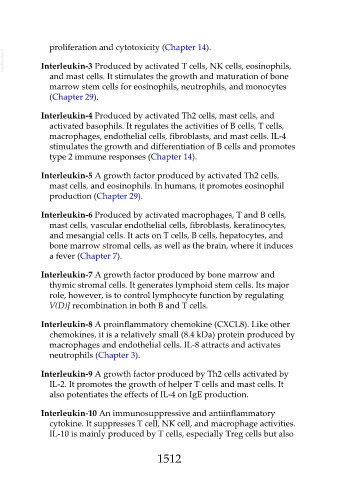Page 1512 - Veterinary Immunology, 10th Edition
P. 1512
proliferation and cytotoxicity (Chapter 14).
VetBooks.ir Interleukin-3 Produced by activated T cells, NK cells, eosinophils,
and mast cells. It stimulates the growth and maturation of bone
marrow stem cells for eosinophils, neutrophils, and monocytes
(Chapter 29).
Interleukin-4 Produced by activated Th2 cells, mast cells, and
activated basophils. It regulates the activities of B cells, T cells,
macrophages, endothelial cells, fibroblasts, and mast cells. IL-4
stimulates the growth and differentiation of B cells and promotes
type 2 immune responses (Chapter 14).
Interleukin-5 A growth factor produced by activated Th2 cells,
mast cells, and eosinophils. In humans, it promotes eosinophil
production (Chapter 29).
Interleukin-6 Produced by activated macrophages, T and B cells,
mast cells, vascular endothelial cells, fibroblasts, keratinocytes,
and mesangial cells. It acts on T cells, B cells, hepatocytes, and
bone marrow stromal cells, as well as the brain, where it induces
a fever (Chapter 7).
Interleukin-7 A growth factor produced by bone marrow and
thymic stromal cells. It generates lymphoid stem cells. Its major
role, however, is to control lymphocyte function by regulating
V(D)J recombination in both B and T cells.
Interleukin-8 A proinflammatory chemokine (CXCL8). Like other
chemokines, it is a relatively small (8.4 kDa) protein produced by
macrophages and endothelial cells. IL-8 attracts and activates
neutrophils (Chapter 3).
Interleukin-9 A growth factor produced by Th2 cells activated by
IL-2. It promotes the growth of helper T cells and mast cells. It
also potentiates the effects of IL-4 on IgE production.
Interleukin-10 An immunosuppressive and antiinflammatory
cytokine. It suppresses T cell, NK cell, and macrophage activities.
IL-10 is mainly produced by T cells, especially Treg cells but also
1512

